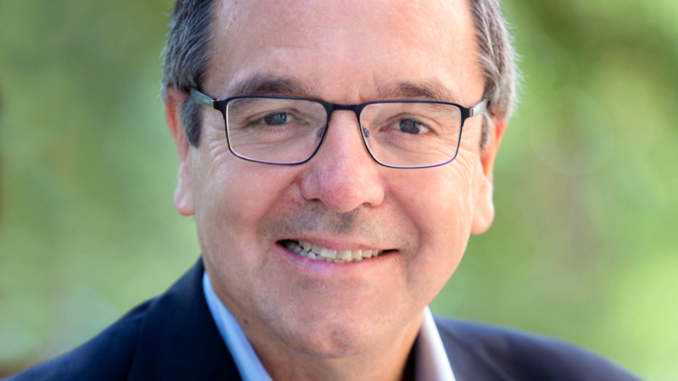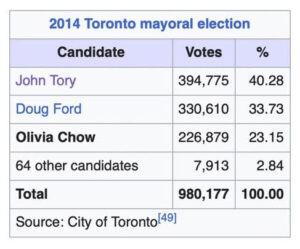
“A man’s gotta know his limitations.” – Clint Eastwood as Dirty Harry in Magnum Force (1973)
Last Wednesday, Gil Penalosa, who finished 2nd in last October’s Toronto mayoral election with 98,525 votes, announced he decided not to run in the current June 26th byelection. Instead, Gil has decided to endorse Olivia Chow in hopes of uniting the progressive votes behind her.
Currently, 50 candidates are running to be Toronto’s 66th mayor. Toronto’s next mayor will likely receive less, much less, than 20% of the vote due to the votes being split amongst 50 candidates.
Getting more votes than your opponents is all it takes to win Toronto’s first-past-the-post election. Given the large number of high-profile candidates running, there is no doubt that the winner of the upcoming Toronto by-election will win with much less than half the votes. Hence, a small number of Torontonians will have chosen Toronto’s next mayor, and the majority will be frustrated that their candidate was not elected.
There is a strong possibility that voter turnout will be low. It is most likely that on Tuesday, June 27th, Torontonians will find themselves in the hands of a mayor who, despite only receiving a fraction of the 1.9 million eligible votes, controls an annual budget of $16 billion and has veto power over the city’s councillors.
Our electoral system is indeed in need of a tune-up. However, our electoral system would not be “as broken” if the majority of eligible voters voted, resulting in more decisive elections.
I thought Gil had a good chance of winning if he focused on growing his voter base, who had just voted for him six months ago.
In case you are wondering why I thought Gil had a good chance of winning, it is because the math was in his favour.
- Presume a 40% voter turnout, an increase of 10% over last October’s election. (fingers-crossed) A 40% voter turnout would result in 760,000 votes being cast. (Hopefully, I am wrong, and the voter turnout will be higher than 40%.)
- Last October, Gil received 98,525 votes.
- Nine candidates currently dominate this election. (Ana Bailão, Anthony Furey, Brad Bradford, Giorgio Mammoliti, Josh Matlow, Mark Saunders, Mitzie Hunter, Olivia Chow and Rob Davis). These are the candidates who are getting media attention, showing up in polls, and are likely to be invited to debates.
- Assuming Gil kept his voter base from last October’s election and grew it slightly to over 100,000 votes—a possibility I would have bet on—that would leave 660,000 votes for the rest of the mayoral candidates, 41 of whom, for lack of a better word, are “marginal.”
- If the 41 marginal candidates receive 5,000 votes combined, this will leave 665,000 votes to be divided among the nine currently dominating candidates, which averages 73,889 votes per candidate. Therefore, thanks to Toronto’s first-past-the-post electoral system, with 100,000 votes, Gil would win.
Before you scoff at my presumption that 41 candidates would get only 5,000 combined, look at Toronto’s 2014 election, which had 67 mayoral candidates. Combined, John Tory, Doug Ford and Olivia Chow received 952,264 votes. The remaining 64 candidates received a total of 7,913 votes.

I admit my math is overly simplistic and populated with presumptions; however, I am illustrating two points:
- Vote splitting will be a significant factor in this election. It would have favoured Gil, as it will favour the nine dominating candidates, and
- This election is a good argument for rank-choice voting, a topic no candidate has mentioned thus far.
50 mayoral candidates is counterproductive. Gil makes a valid point that progressive voters need to unite around one candidate and not split the votes in favour of right-leaning candidates. Likewise, right-leaning voters need to unite around one candidate to avoid splitting their votes in favour of left-leaning candidates.
As this election progresses, I am interested to see which candidates will stand out, and voters will rally around, because they best represent left-leaning or right-leaning political ideologies. Clearly, Olivia Chow represents the left, and Mark Saunders solidly represents the right, though I wonder if Saunders has the political acumen to mobilize the right. I think Ana Bailão has a good chance of doing so.
Should Torontonians choose a left and a right champion, and I expect they will, Toronto could experience a vote-splitting scenario similar to that in 2014, especially if a candidate who espouses centralist political values—a position that advocates for social equality and a lessen hierarchies of privilege while opposing proposals that alter the city’s fiscal management and policies that would benefit either the left or the right in a significant way—instead of the divisiveness the mayoral candidates have displayed so far. Toronto needs a charismatic leader capable of bringing Torontonians to a middle-ground consensus, something none of the 50 candidates has demonstrated.
By deciding not to run, Penalosa showed not only class but also showed he is not motivated by vanity. Gil knows you do not need to be elected to make a difference in your community or city. Regardless of your feelings about Gil’s endorsement of Olivia Chow, he did what he felt was in the best interest of this election and Toronto.
Not surprisingly, this election, like all elections, has its share of what I call “vanity candidates.” While a known candidate can be a vanity candidate, vanity candidates are usually unknown candidates with no political experience, nor have they done any preparatory work to be mayor of North America’s 4th most populous city. (e.g., put a team together, establish relationships with potential donors and the media, put together a platform with well-thought-out positions and suggestions costed-out, have established a healthy social media presence)
Viable mayoral candidates have:
- Extensive community experience. (Shows what they care about.), and
- Experience in city hall or holding a visible public office. (Being mayor of a city the size of Toronto is not a ‘learn on the job’ position.)
They also have the big three needed to run a competitive campaign:
- Money
- A team
- Visibility
Vanity candidates believe they can simply show up on the scene and get votes, or they just want to see their name on the ballot or say they ran for mayor.
Following up on my earlier comment, “a known candidate can be a vanity candidate,” several people have asked me if I think Olivia Chow is a vanity candidate. I believe she is. I have no doubts that the media, seeking to control this election’s narrative, reporting before Chow had filed her nomination papers on several polls forecasting she would get a good deal of support, greatly influenced her decision to run.
Before running for mayor, Olivia Chow needed to know that she was still loved.
In all fairness, Chow has earned her political dues and is undeniably well-known throughout Toronto. Nevertheless, there is the question of where was Olivia Chow last October? This question—Where were you last October?—should be asked to all nine front-running candidates. Did Chow not feel Toronto needed her last year? Maybe her people told her Torontonians preferred John Tory to her.
Vanity candidates know who they are and have become as much a part of our political life as selfies and cheesy smartphone videos. Vanity candidates with little to offer voters attack their opponents’ platforms and proposals, a strategy that never results in votes. Vote splitting is not a concern for vanity candidates.
Gil Penalosa read the room and decided he would not be another vanity candidate, for which we should applaud him.
Every Torontonian following this by-election knows the elephant in the room: Too many candidates are running!
Many candidates need to drop out. Every candidate claims they care about Toronto’s future; at least, that is what they want Torontonians to believe. If this is true, then now is the time to set aside their respective ego, self-reflect on their chances of winning this by-election, and honestly read the room, as Gil did.
Candidates, especially marginal ones, should take a page from Gil’s playbook and volunteer for a front-running candidate that aligns with their values and vision for Toronto. (A great way to gain experience and visibility.)
Unless the field of mayoral candidates decreases to 10-15 candidates or Torontonians unite around 3-5 candidates, this election will be an election where Toronto’s next mayor will be grossly unrepresentative of the leadership most Torontonians want in city hall.
Friday, May 12th @ 2:00 PM is the deadline for candidates to withdraw their candidacy so their names do not appear on the ballot.
____________________________________________
Nick Kossovan, a self-described connoisseur of human psychology, writes about what’s on his mind from Toronto. You can follow Nick on Twitter and Instagram @NKossovan

Leave a Reply